High heels, whether you wear them or not, can’t be certainly ignored. The kind of poise, grace and elegance one feels when wearing high heels, cannot be felt with other forms of footwear. That is the reason that in spite of knowing the pitfalls of wearing high heels, the heels are going higher and higher.
Wearing heels for special occasions once in a while is pretty okay and is not going to cause any lasting damage, but wearing them on a regular basis is what makes it a cause for worry. Short people especially have a tendency to wear them regularly in their efforts to look taller.
Statistics shows an astounding 7-8% of women suffer injuries due to wearing high heels, so severe that they need hospitalized medical attention.
Anatomically speaking, when you put a bare foot on the ground, the front of your foot (the ball) soaks up 43% of your body weight and the back of your foot (the heels) is responsible for the remaining 57% of your weight. As the height of the shoe heel goes up, the weight distribution on the foot gets disturbed, with more weight falling on the balls and less on the heels.
As soon as the heel height goes above 4 inches the weight distribution on the foot reverses. With 6-inch heels almost 75% of your body weight is balanced on your balls and with 10-inch heels 90% of the body weight is borne by the balls.
This severe disparity leads to changed body posture and also alters the natural shape of your feet and resulting into an adverse impact starting from your foot riding all the way up to your neck. Studies and research shows that women are four times more prone to foot injuries as compared to men because of wearing high heels.
Let us see how wearing high heels on a regular basis disrupts and harms our normal body posture and functioning.Are High Heels Bad for you
Problems Caused by High Heels
Ankle strains and sprains:

The first body part to get adversely affected by the heels is your ankles. Lateral strains and sprains as they are called happen when you roll on to the side of your foot and lose your balance and this kind of sprain is very common amongst women wearing high heels on a regular basis. As soon as the height of the heels goes above 3.5 inches, vulnerability to these sprains increases. In case of stilettoes, the weight of the body literally is on pinpoints, making the walk shaky and increasing the chances of a fall.
The balls of the feet, in order to balance the excess weight that they have to bear, contract and shorten which leads to shortening of the muscle fibers and hardening of the Achilles tendons. These changes in the muscles and heels restrict the natural movement of the ankle, shortening the range of movement thus causing one to roll over and fall if one is not careful. This causes the ankle ligaments to stretch beyond its normal capacityand sometimes if the fall is too hard the ligaments can also tear, or the ankle can get fractured.
Under all these circumstances, the foot needs to be administered immediate medical attention, and complete restriction of movement is the only solution for healing.
Deformed toes:

High heels push all the body weight toward the balls of the foot, putting pressure on the toes. The toes contract and squeeze together making abnormal bends in the toe joints in an effort to bear the weight and keep the body stable.
Continuous use of heels leads to hammertoe, wherein the toe joints become frozen in the abnormal position that they had taken to support the body. Hammertoes can be very painful and sometimes surgery is the only solution to relieve the excessive pain.
Ingrowth of toenails:

High heels not only put pressure on the balls of the feet, they mostly have a design that tapers narrow to the front. This leads to squishing of the big toe, which in turn interferes with the natural growth of nail. The nail starts growing into the skin because of the constant squeeze.
In medical terms known as Onychocryptosis, ingrown toenails can lead to swelling of the big toe, resulting in pain and sometimes it can become infected and get filled with pus.
A small surgery cutting open the skin and helping the nail come out is normally the only solution left in this case.
The toes constantly squished together for long periods can also lead to nails pressing into the skin of the next toe, leading to wounds and cuts.
Squished feet also lead to reduced blood circulation in the feet, which can be fatally dangerous for people suffering from Type 2 diabetes.
Bunions:
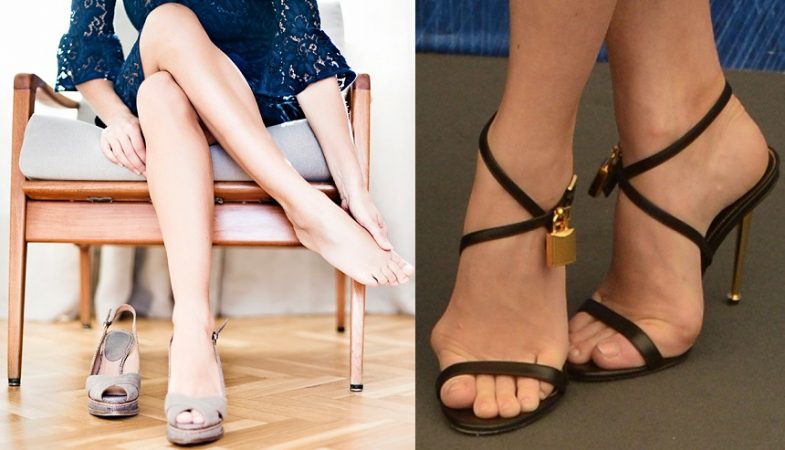
A lot of times you will see people with abnormal shape of the thumb of the foot, wherein the bone at the base of the big toe is protruding out and the thumb itself is tilted significantly inwards towards the other fingers. This is called a bunion, which develops due to prolonged wear of high heels and narrow ended shoes. The bones and tissues located at the base of the foot thumb get dislocated resulting in painful reshaped toes. The part of the foot where the two fingers overlap also becomes prone to calluses, corns, swelling.
Normally there is medical intervention needed to cure bunions, but if pain becomes unbearable or you start having difficulty in finding shoes, then it is advisable to consult a podiatrist.
Sore calves:
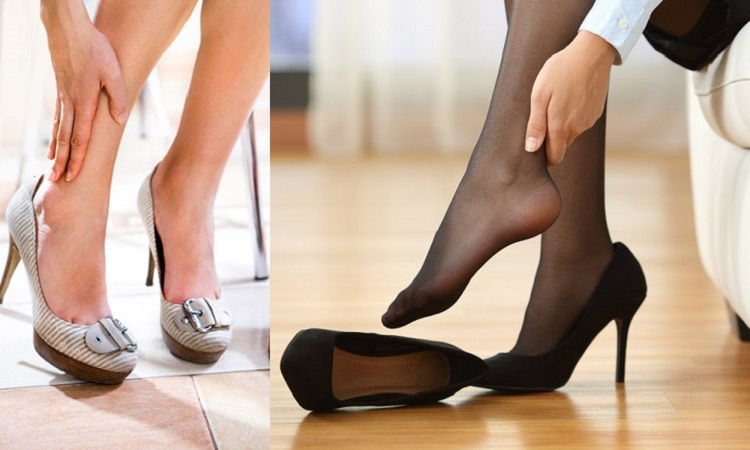
Pressure on the balls leads to tense calves as they try to support the feet. Over a period of time this can lead to calf contracting and the muscles during the lifetime can become 13% shorter. The veins in the calf also start protruding out, not only looking unpleasant but are also very painful.
Lower back pain:

Wearing heels puts pressure on the calves of the legs, which moves up towards the thighs and hips, leading up to the spine and straightening the spinal cord in contrast to its natural shock absorbing S curve, which de-stresses the vertebra. Overuse of these muscles coupled with abnormal lower pelvic movement results in excessive stress on the lower back, which is trying to balance the pressure from the spine as well as from the legs. Invariably it results in lower back pain.
For people suffering from arthritis, wearing heels aggravates lower back pain as the bones and joints are weak to begin with and the back is unable to bear unnatural pressure.
Foramina Stenosis:

Foramina are the space in the spinal cord between two vertebras. When the distance or gap reduces in the spine due to postural abnormalities, one experiences shooting pain starting from the lower back going down to the thigh right up to the leg, numbness, cramps, tingling sensation and weakness in the muscles. Popularly this is also known as sciatica pain.
Posture changes:
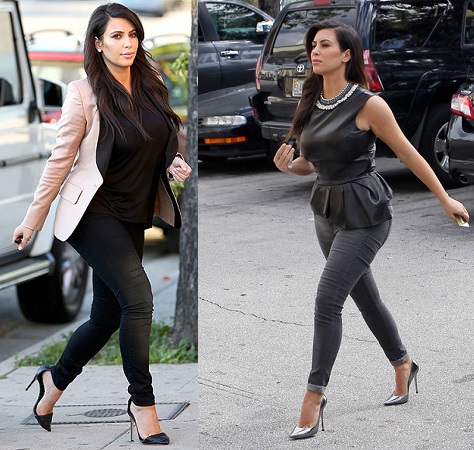
When wearing high heels, the lower part of the body is pushed forward. To balance this, the upper body moves back completely changing the natural posture of the body. As opposed to wearing flat shoes with heels, the lower back due to pressure on the calves and thighs gets pushed forward, displacing the spine and hips.
Prolonged use of heels can lead to permanent postural problems like:
Forward head posture:

Here the cervical spine leans forward in a misaligned manner sometimes leading to severe upper back and neck pain.
Pelvic anteversion:

This is a condition where the hips are jutting back out permanently as opposed to having a gentle curve along the body.
Knee valgus:

Here the knees literally rotate or get displaced externally because the hips rotate internally due to the pressure of the heels. The knees sink in towards the center permanently as when one might squat on the floor.
Lumbar hyperlordosis:
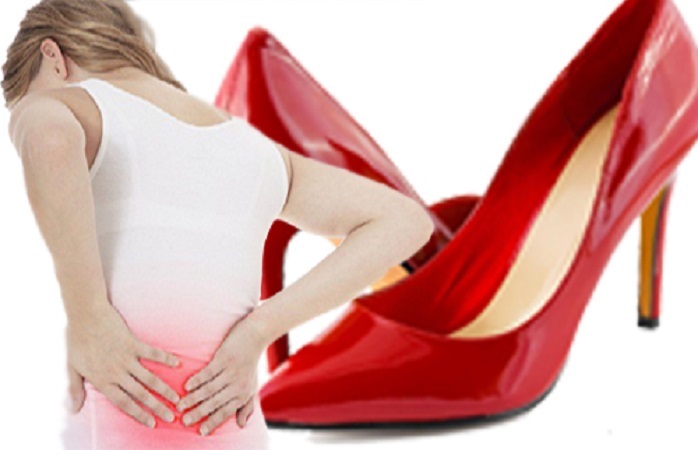
Wearing high heels causes the lumbar spine or the lower back spine to lean inwards excessively, leading to inflammation, swelling and back pain.
Nerve Damage:
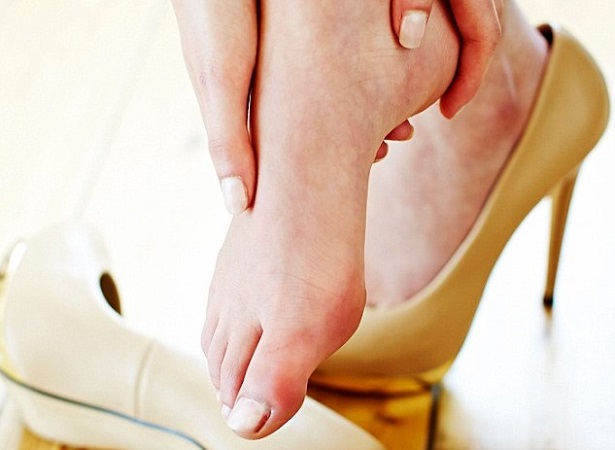
Nerve damage is called neuroma, and the most common kind of nerve damage happens in the foot area and is called Morton’s neuroma. Women are more susceptible to this than men owing to high heels.
Neuroma is the growth of tumor in nerves. Normally neuromas are benign but they are formed as a result of trauma to the nerves over a sustained period of time leading to swelling and thickening of the nerves between the toes making walking also a painful task. The squished nerves are also prone to sharp burning bouts of pain.
Prolonged wear of heels higher than 2 inches ups the risk of developing Morton’s neuroma.
Heel bone protrusion:

The bone at the heels starts protruding due to wear of shoes made from rigid materials. Normally shoes that have medium to high heels have sturdy and rigid backs to provide better support. But this leads to blisters, swelling, bursitis and sometimes-even pain in the Achilles tendon. Over a period of time the bone starts protruding out from the heel because of the formation of a knot at the back of the heel.
This condition has been knick named Pump Bump by women!
Once developed you cannot get rid of the protrusion, but applying ice packs and using heel pads in the shoes can help relieve the pain.
Permanent Pain:
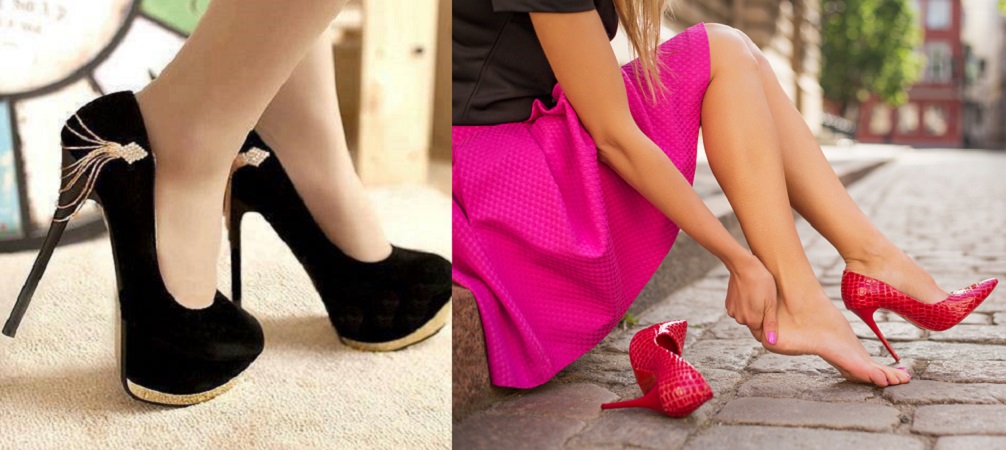
High heels put excessive stress on the balls exactly where all the critical bones of the foot- long metatarsal bones, tiny sesamoid bones and phalanges or toe bones meet. Continuous pressure on this joint can lead to swelling or inflammation of the nerves and bones in extreme cases even causing hairline fractures!
Due to this even when you take of your heels you will experience pain in your feet and find moving around in lower or flat heels also difficult. Sometimes if you are associating pain in your feet to running or jogging, it might actually be a result and hangover of high heel usage.
Soaking your feet in hot salt water can help reduce inflammation and relax the feet.
To sum up in short on how high heels are bad for us:
• Toes get affected leading to deformity
• Ankles become prone to sprains
• Calf muscles contract and shorten
• Knees become weak and inverted
• Hips permanently protrude out
• Lower back pain becomes a common feature
• Spinal cord gets affected
• Neck starts protruding forward
• Complete body posture gets affected
• Nerves get damaged
• Muscles contract and stiffen
How to protect feet from ill effects of high heels?
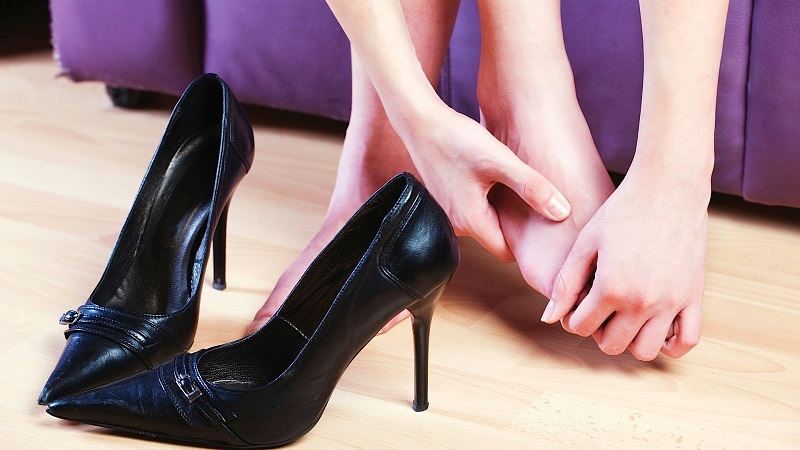
In spite of having a detailed knowledge on how bad heels are for us, most of us are not giving them up any time soon! Instead of giving them up completely, we can smartly wear them so that we can have the best of both worlds, where in we not only look good but also do not put our feet through torture daily.
A few changes that we can make in our lifestyles, which can be beneficial for our feet, are as follow:
Wear your heels smartly and judiciously.

Wear flats or sneakers when sitting at your work place or commuting from one place to another. Carry your heels in your bag and change into them once you have to enter a party or a meeting.
Stretch your feet before and after wearing heels.
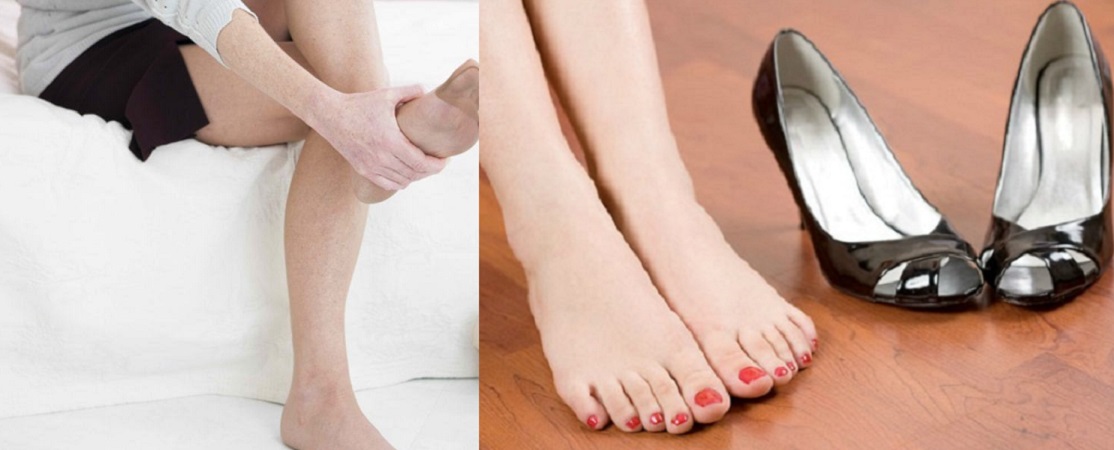
Choose heels that are less than 4 inches, if they are higher then avoid stilettoes and opt for wider bases as they give more stability to the body and minimize the risk of falls.
When buying heels, make sure the front of the shoe is not stiff and has a little flexibility so that the foot has easy movement.
Prefer wedges to pencil heels.
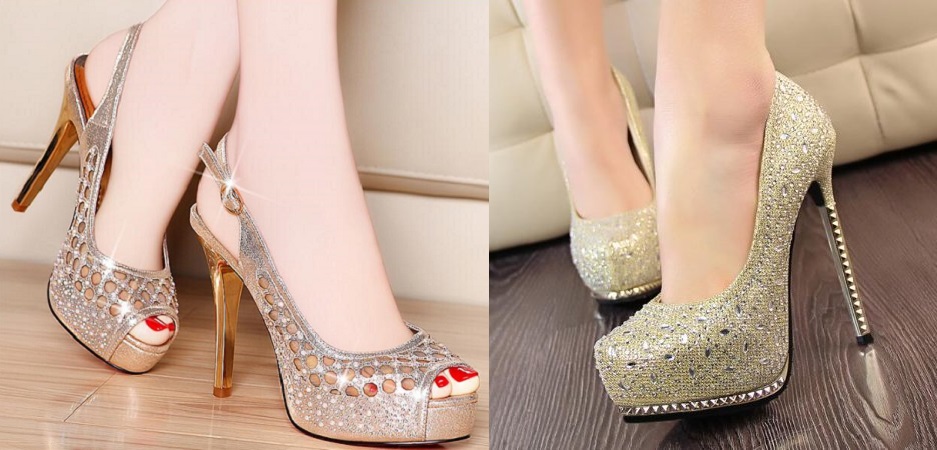
Buy shoes in the evening when your feet are swollen from moving around the entire day.
Buy shoes that have leather insoles so that the feet have better grip.
Buy the correct sized shoe. Shoes smaller than your actual size will have repercussions, even if you are wearing flats.
If you need to be wearing heels for a long period of time without any respite in between, do what the celebrities do! Wear a shoe size bigger than your actual size. Place silicon pads at the heels to hold the shoe in place. The bigger size gives the foot place to breathe and the silicon pads make sure you do not trip and fall. It is a win-win situation.
Try to buy shoes that have a wider front to be able to accommodate your toes comfortably. If you are buying pointed shoes, then the tapering should start once your toes are comfortably placed and the tips from both the sides of the foot are not gettingpressed.
Buy shoes that have a soft back to avoid calluses and blisters. If the shoes are stiff backed, then use heel pads to protect your heels.
Keep your toenails trimmed preferably straight across so that they do not cut through the skin.
Take off your heels wherever and whenever you get a chance and gently stretch and massage your feet.
Daily stretch your calf muscles to avoid them shortening.
Soak your feet in hot salt water once at home to relax and soothe inflamed feet.
Our feet carry us everywhere throughout our lives and the least we can do is take care of them, nourish and cherish them.
The question that we need to ask ourselves is- why does fashion have to be painful? Can’t we feel good about our individuality and self without putting our body through this pain?
The famous French shoemaker Christian Louboutin once in an interview said that he only knew how to make women look sexier and pretty. He did not care about how the heels adversely impacted their bodies.
So we are willing to pay a bomb for ruining our own health voluntarily?
Why do men not have to endure pain to show their sexiness?
The question are endless and if we do not have answers to them, the least we can do is wear our heels smartly and be sexy and pretty and confident through our attitudes and not our heels!






